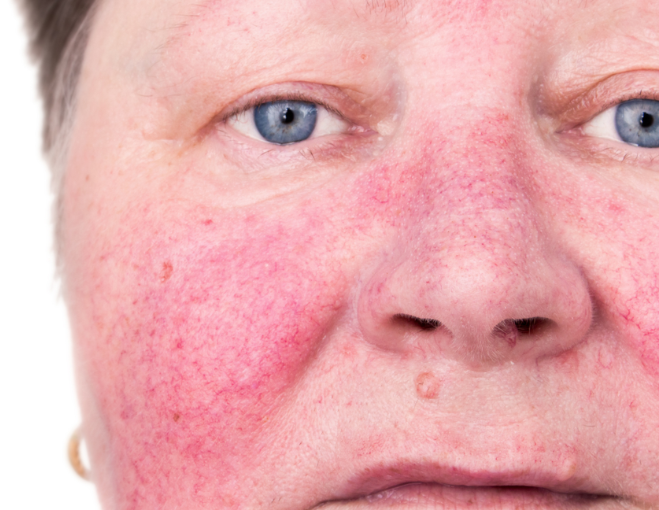Understanding what’s really going on beneath the redness.
Let’s talk about a condition that often goes undiagnosed, mislabelled as “sensitive skin,” and leaves people feeling embarrassed, confused, or frustrated: rosacea.
If you’ve noticed ongoing redness across your cheeks or nose, small visible veins, frequent flushing, or bumps that look a bit like acne—this one’s for you.
What Exactly is Rosacea?
Rosacea is a chronic inflammatory skin condition that mostly affects the face, particularly the cheeks, nose, chin and forehead. It’s often confused with acne, sensitivity or even allergies—but it’s actually its own unique condition.
The key symptoms include:
• Persistent redness or flushing
• Visible capillaries (called telangiectasia)
• Bumps or pustules (rosacea can look like acne, but it isn’t)
• Burning, stinging or tightness
• Flare-ups triggered by heat, stress, skincare, food or alcohol
What Causes Rosacea?
The exact cause isn’t fully understood, but we do know it’s linked to:
• Vascular hyper-reactivity (your blood vessels are overly responsive)
• Inflammation in the skin and gut
• Compromised skin barrier function
• Genetics – it often runs in families
• Demodex mites – a type of skin mite that lives on your skin but may overpopulate in rosacea-prone skin causing inflammation.
Rosacea is not caused by poor hygiene, and it’s not just surface redness—it’s a sign that your skin is reacting to internal and external triggers.
Common Rosacea Triggers
Understanding your triggers is key to reducing flare-ups. These vary from person to person, but common ones include:
• Hot drinks and spicy food
• Alcohol (especially red wine)
• Heat or sun exposure
• Intense exercise
• Stress or anxiety
• Overly active or fragranced skincare
If any of these seem familiar, your skin could be trying to tell you something.
The Problem With “Sensitive Skin” Labels
Many people with rosacea end up treating it as if it’s just sensitivity—using rich creams or barrier balms and skipping professional guidance. But here’s the thing: rosacea is not just sensitive skin—it’s inflamed, reactive skin that needs a tailored, calm but strategic approach.
Over-moisturising, scrubbing, or piling on thick products can actually make it worse.
How We Treat Rosacea in Clinic
There is no “one cream cures all” when it comes to rosacea—but we do have highly effective ways to manage and reduce it.
In clinic, we work to:
• Calm inflammation and strengthen your skin barrier
• Soothe blood vessel reactivity
• Minimise flare-ups and reduce redness over time
• Support internal triggers, such as gut and stress imbalance
Every plan is customised—because every rosacea case is different.
The Bottom Line? You’re Not Alone
Rosacea can be incredibly emotional to deal with, especially when flare-ups happen out of the blue or makeup just won’t sit right. But you are absolutely not alone—and more importantly, you don’t have to keep struggling on your own.
With the right knowledge, treatment, and support, rosacea can be calmed, controlled, and in many cases—almost invisible.
Let’s Create Your Calm Skin Plan
If you’re struggling with redness, sensitivity, flushing or unexplained skin flare-ups, book in for a consultation and let’s uncover what’s really going on.
We’ll create a personalised rosacea treatment plan that fits your skin, lifestyle and goals—because healthy skin is calm skin.


